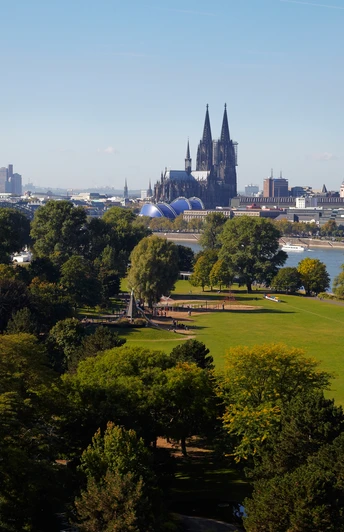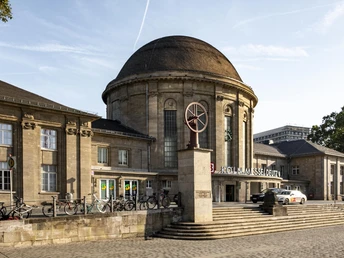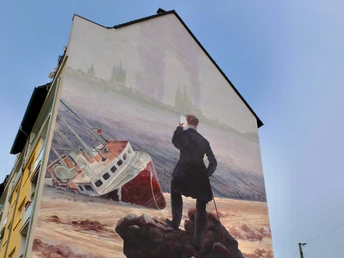- Photos & Map
How would you like to arrive?
- Details
- Useful Information
- Nearby
- 1:48 h
- 27.61 km
- 70 m
- 72 m
- 38 m
- 61 m
- 23 m
- Start: Cologne Cathedral
- Destination: Cologne Cathedral
As the name suggests, Cologne’s right bank, known as the “Schäl Sick,” is not considered the city’s most attractive side. The term “Schäl” in the Kölsch dialect means skewed, odd, or simply wrong, referring to the historical fact that this area was not originally part of the city and stood in competition with Cologne.
The transformations of the 19th century, particularly the French Revolution and industrialization, also changed the face of the Rhineland and the city of Cologne. As part of Prussia, Cologne expanded beyond its medieval boundaries and across the Rhine.
The "Schäl Sick" became part of Cologne and has remained so to this day. However, the nickname persists as the area continues to have a distinct character – compared to the opposite side.
This cycling tour aims to showcase the raw charm and some culinary gems of the “Schäl Sick.” Along this tour, we will encounter former villages and small towns that became affluent industrial locations and eventually merged into Cologne. Similarly, we can trace how migration from other countries gave neighborhoods Italian, Turkish, Moroccan, and Eastern European influences, and observe how structural changes in the 20th century reshaped these areas anew.
A wild mix of styles awaits us as we travel through the districts of Mülheim, Deutz, Kalk, and Humboldt-Gremberg. On the one hand, we’ll encounter the classical Cologne "Veedels" (neighborhood) charm in Mülheim and Deutz. On the other hand, spots like Keupstraße and Kalk offer glimpses of a neighborhood life with Kölsch-Oriental vibes. Additionally, we will directly experience the transformation from industrial to cultural quarters. The industrial buildings of the 19th century now host event venues (Schauspiel Köln, E-Werk, Palladium) and creative and media companies (Brainpool, Bastei Lübbe), among others. This process is far from over, evident at Mülheim’s harbor, where the district is undergoing redevelopment. The Rheinpark serves as a unifying element for the districts on the right bank. This recreational space, originating from the 1954 Federal Garden Show, offers Cologne residents inner-city tranquility in the form of nature, relaxation (Claudius Therme), play, and entertainment. The Tanzbrunnen is one of Cologne’s most beautiful open-air stages.
After passing the historic trade fair grounds, now home to RTL, we reach the Rhine Boulevard. Offering panoramic views of Cologne's Old Town, it’s an inviting spot to pause and linger.
Heading toward Cologne Kalk, we first pass Deutz station and cycle past the Cologne city administration building to reach LANXESS arena. From there, it’s a straight route into Kalk. In Kalk, the contrast between pragmatic post-war housing and modern elements stands out. However, the district also features a few 19th-century highlights (the historic water tower and factory halls). Our ultimate destination is the Sünner brewery, the city’s oldest industrial building that still serves its original purpose: making beer and offering a great opportunity to stop for a bite and a drink.
Finally, we return toward the Cathedral via the bustling Kalker Hauptstraße. A detour through Humboldt-Gremberg takes us along streets influenced by former wealth and migration culture. The tour ends at Deutzer Freiheit in the heart of the right bank, where a delicious Kölsch and meal make for a pleasant conclusion.
The transformations of the 19th century, particularly the French Revolution and industrialization, also changed the face of the Rhineland and the city of Cologne. As part of Prussia, Cologne expanded beyond its medieval boundaries and across the Rhine.
The "Schäl Sick" became part of Cologne and has remained so to this day. However, the nickname persists as the area continues to have a distinct character – compared to the opposite side.
This cycling tour aims to showcase the raw charm and some culinary gems of the “Schäl Sick.” Along this tour, we will encounter former villages and small towns that became affluent industrial locations and eventually merged into Cologne. Similarly, we can trace how migration from other countries gave neighborhoods Italian, Turkish, Moroccan, and Eastern European influences, and observe how structural changes in the 20th century reshaped these areas anew.
A wild mix of styles awaits us as we travel through the districts of Mülheim, Deutz, Kalk, and Humboldt-Gremberg. On the one hand, we’ll encounter the classical Cologne "Veedels" (neighborhood) charm in Mülheim and Deutz. On the other hand, spots like Keupstraße and Kalk offer glimpses of a neighborhood life with Kölsch-Oriental vibes. Additionally, we will directly experience the transformation from industrial to cultural quarters. The industrial buildings of the 19th century now host event venues (Schauspiel Köln, E-Werk, Palladium) and creative and media companies (Brainpool, Bastei Lübbe), among others. This process is far from over, evident at Mülheim’s harbor, where the district is undergoing redevelopment. The Rheinpark serves as a unifying element for the districts on the right bank. This recreational space, originating from the 1954 Federal Garden Show, offers Cologne residents inner-city tranquility in the form of nature, relaxation (Claudius Therme), play, and entertainment. The Tanzbrunnen is one of Cologne’s most beautiful open-air stages.
After passing the historic trade fair grounds, now home to RTL, we reach the Rhine Boulevard. Offering panoramic views of Cologne's Old Town, it’s an inviting spot to pause and linger.
Heading toward Cologne Kalk, we first pass Deutz station and cycle past the Cologne city administration building to reach LANXESS arena. From there, it’s a straight route into Kalk. In Kalk, the contrast between pragmatic post-war housing and modern elements stands out. However, the district also features a few 19th-century highlights (the historic water tower and factory halls). Our ultimate destination is the Sünner brewery, the city’s oldest industrial building that still serves its original purpose: making beer and offering a great opportunity to stop for a bite and a drink.
Finally, we return toward the Cathedral via the bustling Kalker Hauptstraße. A detour through Humboldt-Gremberg takes us along streets influenced by former wealth and migration culture. The tour ends at Deutzer Freiheit in the heart of the right bank, where a delicious Kölsch and meal make for a pleasant conclusion.
Useful Information
Best to visit
suitable
Depends on weather
Tour information
Suitable for Bike
Nearby


